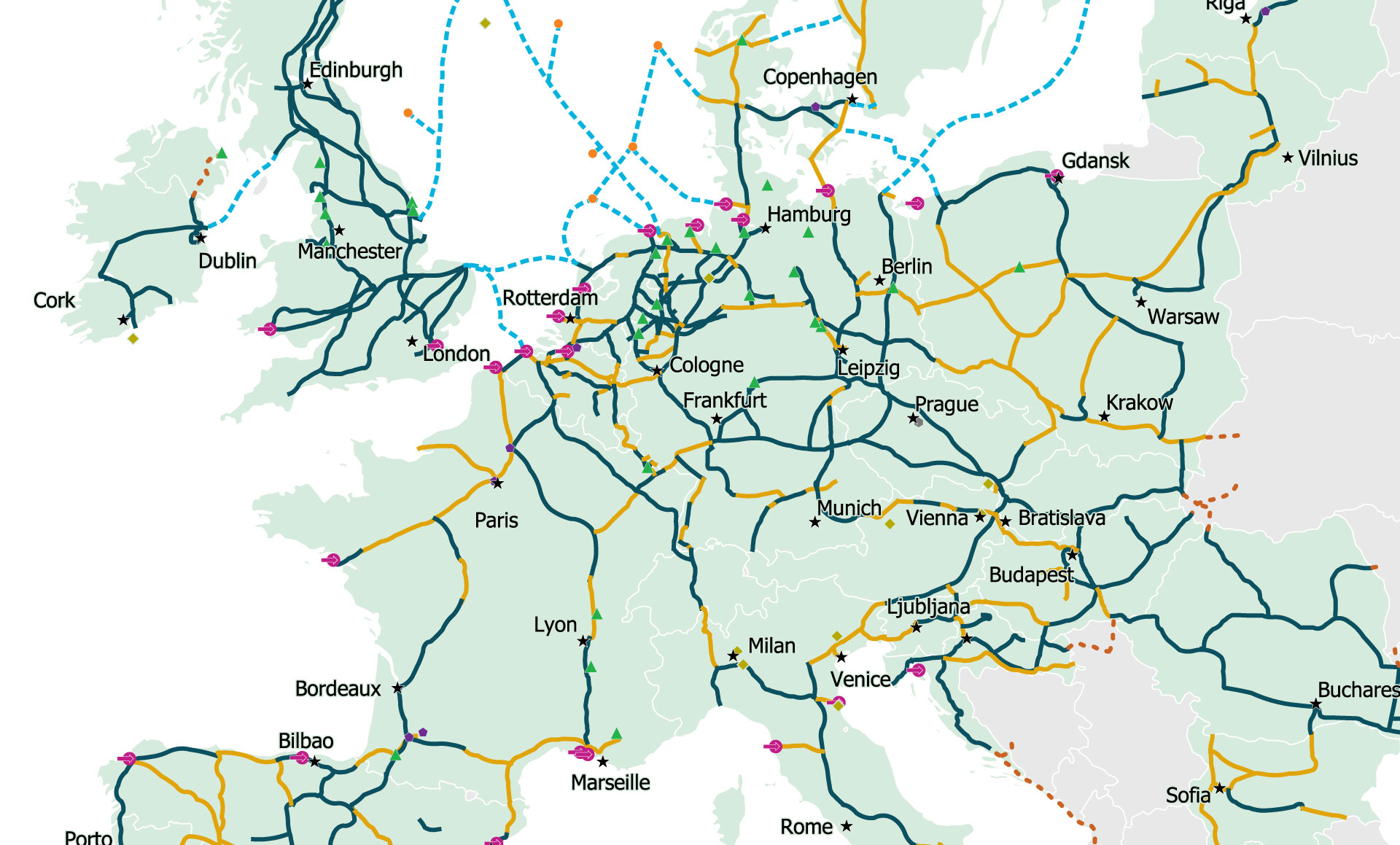America's "stalling" EV transition | AI's increasing carbon footprint | Europe's expensive hydrogen pipeline

infrastruttura
no. 42
Despite the good vibes why is America's EV "revolution" stuck in the mud?
Ask a random person on the street how they feel about electric cars and odds are their feedback will be positive. For example, back in June, a poll found 40% of Americans want to buy an EV. But that anecdotal support has not translated into actual sales for domestic automakers.
During the third quarter of 2023, EVs constituted just 8 percent of new vehicle sales in the US. In fact, just 1 million were purchased - barely 50 percent more than in Europe (where the automobile market is much smaller. For example, in Italy, there are only 45 million cars for over 60 million Italians. This works out to a ratio of about 0.75 cars per person, compared to .79 in Australia and .91 in the US. The global average is .22 cars per person.)
Worse still by comparison, the Chinese bought 4 times as many EVs as Americans last year. Just three states (California, Texas, and Florida) account for about half of new EV registrations in the US. And 92 days worth of EV inventory remains on US dealership lots this holiday season versus just 54 for ICE vehicles. After all the post-IRA and IIJA hype about America's EV transition the slow pace of adoption is both a surprise and a problem given that cars themselves create nearly 20% of America's overall carbon emissions.
So what's behind America's struggles to make the EV transition? There are a few key problems. First is the EV pricing structure. Today the typical EV sells in the US for $52K (just over the average ICE vehicle's price of $48K). But the total cost of owning an EV today is actually higher due to the cost of installing at-home charging infrastructure, EV-specific insurance premiums that are stubbornly high, and the relatively low price of gas in the US (as compared to the EU and China).
Second, while on paper it looks great, the federal government's $7500 tax credit for new EV purchases is finicky; eligibility for various EV models is confusing thanks to opaque Buy America Act supply chain requirements. Finally, cheaper EVs are hard to find. Not only are Chinese models effectively excluded from the US market thanks to tariffs and other red tape, but GM and Honda recently canceled plans to build a $5B EV plant in the US that was slated to build less expensive alternatives. Ford and Tesla have announced similar delays too. (Toyota however did recently announce plans to increase its investment in a North Carolina EV battery manufacturing facility by $8 billion.)
While many EV manufacturers are slashing prices to move inventory out of US dealership lots this will not be enough on its own to jumpstart the EV revolution. Instead, firms are delaying investments in the hope that the market turns soon. America's ability to hit its climate targets may depend on it. (The Economist)


Infraquote of the week.
"The future of American green buildings lies in embracing the potential of bio-based materials. We're talking about hempcrete walls, mycelium insulation, and even mushroom-based bricks. These aren't just eco-friendly alternatives – they're stronger, lighter, and even offer natural antimicrobial properties. By investing in sustainable materials research and incentivizing their adoption, we can build a future where our buildings are not just energy-efficient, but truly regenerative for our planet."
Vermont state senator Sarah Jones, speaking at a conference on sustainable materials and green building innovations held in Burlington on November 18, 2023.
AI's carbon footprint is already massive, and it's still growing.
For the first time an academic study has calculated the carbon footprint created by AI inquiries (although it hasn't been peer-reviewed yet). Researchers at Carnegie Mellon and the AI startup Hugging Face analyzed the carbon emissions from ten of the most popular inquiries on the startup's platform (answering questions, generating images, etc.) using a script called Code Carbon to calculate the amount of energy consumed by the computer serving the inquiry.
The results were both interesting and, from a climate perspective, sobering. Generating a single image using AI required as much energy as fully charging a smartphone. Those from text-only inquiries fared better, generating only 16 percent of that amount for 1000 inquiries combined. But according to the study creating 1000 images with an AI-powered model will generate the same amount of carbon emissions as driving about 4 miles in your ICE vehicle.
Training AI models uses a lot of energy too. But it's the actual use of these models that will ultimately generate the bulk of their significant carbon impact, adding up quickly as millions and even billions of inquiries run every day on AI-powered platforms. (One estimate counts the number of ChatGPT users alone at over 10 million every day.)
The study also points out an important distinction in carbon footprint between different types of AI models. For example, an AI that performs a specific task will be nearly thirty times less carbon-intensive than one that is generative. Yet new models and products are moving in the opposite direction. For example, Google once claimed its legacy search function required just 0.3 watt-hours (equal to the emissions from driving .0003 miles in an ICE vehicle). But because the Google search function now includes generative AI the carbon footprint of even a regular Google search is likely much higher (but today that actual figure remains unknown).
The point of the research is threefold. First, to get all of us to be more selective when choosing to use (or ignore) AI-powered tools. Markets should also pressure the tech industry to develop data centers and other computing platforms that are powered by renewable energy sources. And AI tools should be more focused and specialized in order to minimize their energy and carbon intensity. It's reductive, of course, but if we care about the planet let's get out our old Encyclopedia Britannicas before serving up another inquiry to Bard or ChatGPT. (MIT Technology Review)


Infrastat of the week.
27: the number of different transit agencies in the San Francisco Bay Area. Unlike other parts of the world, America's public transit systems are highly fragmented, creating cost and complexity that make it the world's most expensive market to build new transportation assets.

The EU is building a continent-wide hydrogen pipeline network but it's not going to be cheap.
The cross-border, 53,000-kilometer "hydrogen backbone" that Europe hopes to build by 2040 will unfortunately cost billions of Euros more than planners initially thought. The European Hydrogen Backbone, a consortium of 33 energy companies which is trying to construct the pipeline, acknowledged recently that the price tag for the project, which had been estimated at $87 billion to $150 billion, might be "massively" underestimated thanks to the lingering impacts of post-pandemic supply chains and inflationary pressures.
The consortium's new report on the project, Implementation roadmap - Cross border projects and costs updates, concluded that the average price for the network's components has increased, in some cases dramatically. For example, since 2019 the average per-kilometer costs of onshore hydrogen pipelines have increased across the EU by a heady €300,000 for 20-inch-diameter pipes, €1m for 36-inch-diameter pipes, and €1.6m for 48-inch-diameter pipes.
The network would include subsea pipelines and connections from the EU to both offshore energy hubs and regions for potential hydrogen exports (including Scandinavia). Plans for the backbone had also called for the consortium to leverage existing infrastructure for 60% of the network but build new pipelines for the rest of it. But now that framework may need to be rethought.
Guidehouse, the consulting firm that generated the report for the consortium, says that an updated estimate "will depend on getting an up-to-date, exact planned make-up of the hydrogen gas grid — such as the exact sizes of pipes used in each stretch and proportion of new versus repurposed pipelines — as determined by its members."
By 2030, the European Union is aiming to have 20 million tons of hydrogen running through this EU-wide system at a cost of around $0.25 per kilogram of hydrogen (when transported over 1000 kilometers). A similar target also exists in the US, where America's Department of Energy announced a "Hydrogen Shot," in June of 2021 to try and drop the cost of green hydrogen from $5 per kilogram to $1 by 2030 (i.e. $1 for 1 kilogram in 1 decade - this would be at the same scale that solar and wind power costs have also decreased over the last decade).
But if individual nodes within the overall EU network are delayed or never completed on account of spiraling costs the continent's goals for the gas could be in jeopardy. Hydrogen, of course, has become an increasingly important alternative to fossil fuels in corners of the economy that are difficult to electrify (like long-haul trucking, freight rail, and various industrial applications). (HydrogenInsight)

Around the industry.
- The University of South Florida has decided to drop design-build as the delivery model for its new football stadium project, citing concerns over supply chain and shifting priorities away from expediting the project schedule. (ENR)
- Most rail systems globally are already electrified - and that will be the case soon too in North America. (Forbes)
- Making public transit "smarter" for riders will increasingly come at the expense of their anonymity. (Engadget)
- American retail spaces are now the smallest they've ever been since CoStar started tracking new leasing activity in 2006. (WSJ)
- Simulating what 30 centimeters of sea rise could look like in the world's major cities over the next 30 years. (CNN)







Member discussion